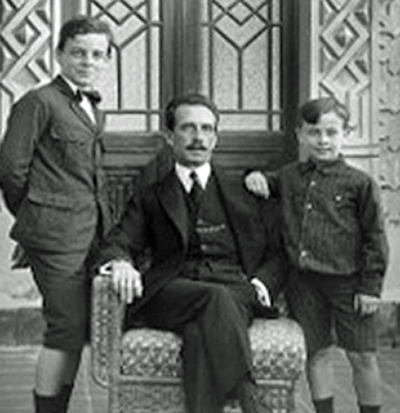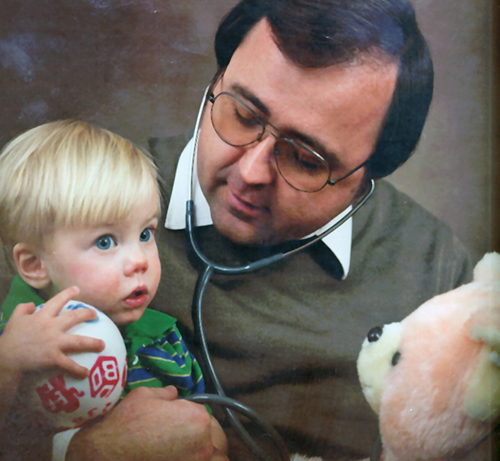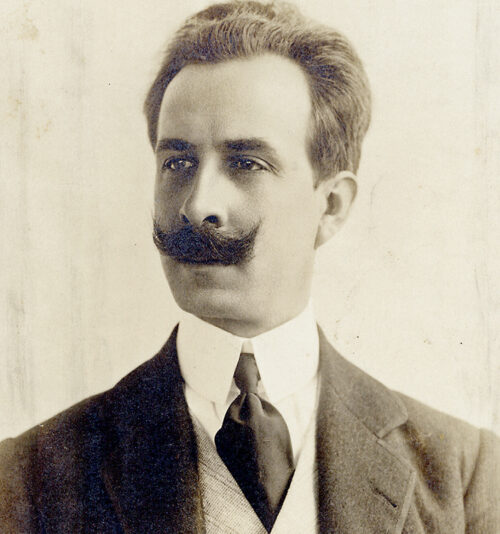Carlos J. R. Chagas – Malaria, American Trypanosomiasis, Pneumocystis
Our “Doctor number 26” in the list of most influential doctors of all time, Carlos Justiniano Ribeiro Chagas, lived in the late 1800’s, before the advent of electricity; so, at night had to study by the light of flames. His rituals, widely known by housemates, neighbors and other students, involved reading into the night for as long as two candles lasted.
His incredible work ethic would eventually lead to a medical degree after recovering from Beri-Beri, discovering the cause of three major diseases, having a disease named after him, two nominations for the Nobel Prize, his picture taken with Einstein and his photo on Brazilian money!
Dr. Carlos Justiniano Ribeiro Chagas
Carlos Justiniano Ribeiro Chagas(1878—1933) – #26
The “Two Candle Doctor”
Hence his irrefutable nickname: “Two-candle student”; probably because other medical students in Rio de Janeiro only used up one candle or less for their nightly studying in the electricity-deficient city.
Early Life and Education of Carlos J. R. Chagas
Chagas was born the eldest of four children, July 9, 1879, to Portuguese parents in Oliveira Brazil, his mother’s hometown. His father was José Justiniano das Chagas, a coffee farmer at Juiz de Fora in Minas Gerais, and who died when Carlos was only four.

His mother, Mariana Cândida Chagas (née Ribeiro de Castro), enrolled him in Jesuit boarding school in São Paulo when he was seven; but needed to transfer him to a closer school two years later, due to the political turmoil caused by Emperor Dom Pedro II abolishing slavery in 1888.
The family spent at least half the year with her family in Oliveira. Carlos entered the School of Mining Engineering in Ouro Preto but had to drop out and return to Oliveira in 1895 when he contracted beri-beri, a severe neurological disease caused by vitamin B1 deficiency.
While in Oliveira, his physician-uncle Carlos Ribeiro de Castro talked to him about attending Medical School, which he eventually did in 1896 at the Medical School of Rio de Janeiro.
Needing to research a topic and write a dissertation in order to receive a medical degree, his mentor suggested he do work on Malaria (whose transmission had just been discovered in India, 1898) and introduced him to Oswaldo Cruz (1872–1917), founder of the Manguinhos Institute, as his guide though the process. A life-long friendship ensued.
Chagas graduated in 1902 with a dissertation on malaria; then, received his doctorate degree with a thesis entitled “Hematological Studies on Malaria” the next year.
Career and Discoveries

His work and writing on Malaria garnered him grants, stipends and requests to solve outbreaks of the disease which led to yet other discoveries. Early in the 20th century he correlated parasites isolated from insects with people who complained of nighttime bites and children suffering from recurrent fevers, anemia, edema, enlarged spleen and lymph nodes and cardiac issues. The disease is today known as “Chagas Disease” – American trypanosomiasis.
And while he did it, his methods for doing it not only set precedents revolutionizing public health and disease control but identified the fungal genus Pneumocystis as well; hence discovering the cause of pneumocystis pneumonia in AIDS patients. He encouraged colleagues to study and try to verify his work.
He proposed and then used the insecticide pyrethrum to rid large areas of South America from insects causing Malaria; thereby preventing the disease.
Eventually he returned to Rio de Janeiro to first join and then direct the Oswaldo Cruz Institute from 1917-34. His work and influence affected public health policy in many South American countries.

Chagas was elected to the National Academy of Medicine and received the prestigious Schaudinn Prize for the best work in protozoology and tropical medicine in 1912. The other contenders for the prize included the notables Paul Ehrlich, Emile Roux, Ilya Mechnikov, Charles Laveran, Charles Nicolle, and Sir William Boog Leishman many of whom had already or would soon receive the Nobel Prize for Medicine. Chagas was twice nominated for the Nobel Prize in Physiology or Medicine, in 1913 and 1921, but never received any.
In 1922, Chagas became member of the Health Committee of the League of Nations; and, since 2020, The World Chagas Disease Day is observed by the World Health Organization every year on 14 April, commemorating the day Chagas discovered T. cruzi from a patient’s blood.
Later life:

It was an instructor in medical school, Miguel Couto, who introduced him to a relative, Fernando Lobo, where he met Iris, Lobo’s daughter who he eventually married. Together, they had two sons: Carlos and Evandro, educated and successful in their own right.
Carlos Chagas Filho (1910–2000) entered the field of neurophysiology and was internationally recognized and the president of the Pontifical Academy of Sciences. Evandro Chagas (1905–1940) took after his father as a physician and researcher in tropical medicine. He, unfortunately died in a plane crash at 35 years of age.
From 1920 to 1924, Dr Chagas (Sr.) set up Brazil’s Department of Health, and became its first director. He was very active in organizing special healthcare and prevention services and campaigns for the Spanish flu epidemics, sexually transmitted diseases, leprosy, pediatrics, tuberculosis, and rural endemic diseases.
He created a nursing school and was the founder of the concept of sanitary medicine, the first chairman of tropical medicine and the graduate study of hygiene.
Chagas died in Rio de Janeiro from a heart attack in 1934 at age of fifty-five.
Nobel Prize controversy:

Chagas’ discoveries were recognized at home and abroad as one of the most important achievements in parasitology and he was nominated twice for the Nobel Prize – 1913 and 1921.
There were many nominees both years; but it may have been the few Brazilian physicians and researchers who expressed “disbelief in the very existence of Chagas disease” (without offering any other alternative) which influenced the Nobel committee.
An unusual analysis of the Nobel Prize archives on the matter, however, seemed to discount local opposition as the reason; and reveal the strong connection the Nobel Committee had with the European and North American scientific community (Eurocentrism) as the more-likely cause of “non-recognition.”
Biographic Summary
Carlos J.R. Chagas was
Born: July 9, 1879
Died: November 8, 1934
Education: M.D., 1903, Medical School of Rio de Janero
Known for: Discovering Trypanosoma cruzi, the agent of Chaga’s disease; and causative agent of pneumocystis pneumonia.
Parents: José Justiniano das Chagas, a coffee farmer at Juiz de Fora in Minas Gerais, and Mariana Cândida Chagas (née Ribeiro de Castro)
26 Posts in Top 50 Doctors (top50) Series
- 26 - Carlos Chagas, Chaga's Disease & pneumocystis pneumonia. – 10 Apr 2025
- 27 - Charles D. Kelman - Cataracts – 9 Mar 2023
- 28 - Cicely D. Williams, Kwashiorkor, Breastfeeding, Whistleblower – 21 Jun 2022
- 29 - Dame Cicely Saunders, Hospice – 23 Apr 2018
- 30 - David L. Sackett, Evidence-based Medicine – 2 Apr 2018
- 31 - E. Donnall Thomas & Joseph Murray, Bone Marrow Transplants – 23 Feb 2018
- 32 - Elizabeth Blackwell, women in medicine – 29 Jan 2018
- 33 - Elisabeth Kübler-Ross, stages of grief – 5 Jan 2018
- 34 - Watson & Crick, DNA – 2 Dec 2017
- 35 - Mahmut Gazi Yaşargil, Micro-Surgery – 24 Oct 2017
- 36 - George Papanicolaou, Cytopathology, Cancer – 29 Sep 2017
- 37 - Dr. James Parkinson, Parkinson's Disease – 1 Sep 2017
- 38 - Dr. John Snow, cholera – 20 Aug 2017
- 39 - Dr. Joseph Kirsner, GI Joe – 27 Jul 2017
- 40 - Lawrence (Larry) Einhorn, chemotherapy – 16 Jun 2017
- 41 - Robert Koch, modern bacteriology – 21 Mar 2017
- 42 - Stanley Dudrick, TPN – 28 Feb 2017
- 43 - Stanley Prusiner, neurodegenerative diseases – 25 Jan 2017
- 44 - Victor McKusick, medical genetics – 3 Jan 2017
- 45 - Virginia Apgar, anesthesiology & newborn care – 12 Nov 2016
- 46 - William Harvey, circulation – 12 Oct 2016
- 47 - Zora Janžekovič, burns – 26 Sep 2016
- 48 - Helen Taussig, blue babies – 3 Sep 2016
- 49 - Henry Gray, anatomy – 3 Jul 2016
- 50 - Nikolay Pirogov, field surgery – 11 Jun 2016
- Top 50 Doctors: Intro/Index – 10 Jun 2016

